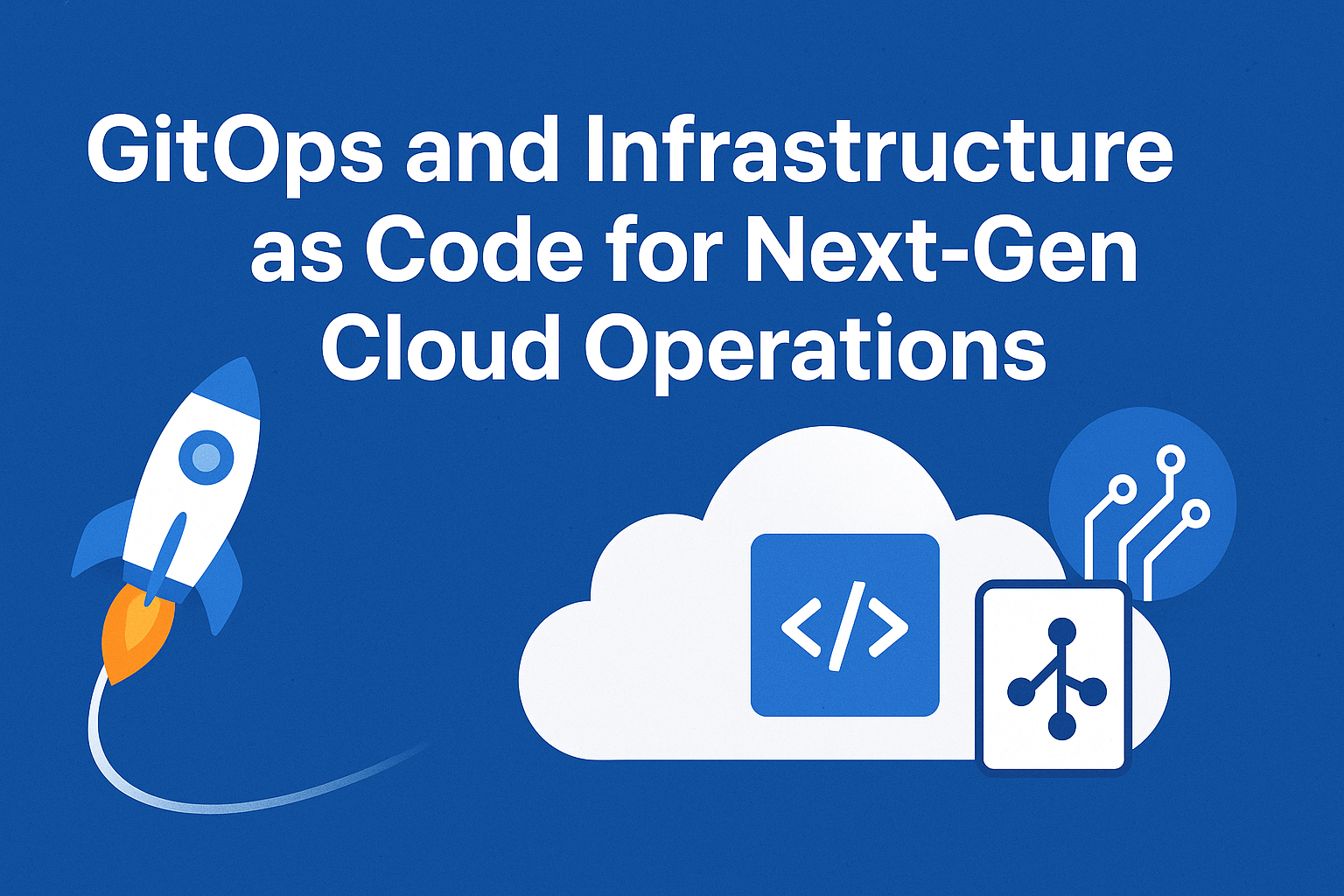GitOps and Infrastructure as Code for Next-Gen Cloud Operations

🔎 Introduction
The cloud-native era has transformed the way we build, deploy, and manage applications. Businesses today demand agility, scalability, and reliability, and traditional infrastructure management methods simply can’t keep up. Manual processes often lead to inconsistencies, slower deployments, and higher risk of human error.
This is where GitOps and Infrastructure as Code (IaC) come into play. Together, they form the backbone of next-generation cloud operations, enabling organizations to automate everything, reduce risk, and accelerate innovation.
👉 As DevOps Engineers, embracing GitOps + IaC is no longer optional – it’s essential.
📜 What is Infrastructure as Code (IaC)?
Infrastructure as Code (IaC) is the practice of defining and managing infrastructure using declarative configuration files instead of manual setups. Think of it as treating infrastructure like application code – stored in Git, version-controlled, and reproducible.
🔧 Popular IaC Tools:
- Terraform 🌍 – Multi-cloud support, highly extensible.
- Ansible ⚙️ – Configuration management and automation.
- AWS CloudFormation ☁️ – AWS-native IaC solution.
- Pulumi 💻 – IaC with familiar programming languages.
✨ Benefits of IaC:
- ✅ Consistency – No more “it works on my machine” issues.
- ⚡ Speed – Spin up environments in minutes.
- 📂 Version Control – Rollback to previous states with Git.
- 🛡️ Reduced Errors – Automate repetitive and error-prone tasks.
- 📊 Scalability – Seamlessly manage multi-cloud and hybrid infra.
📌 Example: A team can define their entire AWS VPC setup in Terraform, commit it to Git, and replicate the exact same infrastructure across dev, staging, and production environments.
🛠️ What is GitOps?
GitOps is an operational model where Git becomes the single source of truth for both infrastructure and applications. With GitOps, the state of your system is stored in Git repositories, and changes are automatically applied via automation tools.
GitOps goes hand-in-hand with Kubernetes but extends far beyond it.
🔧 GitOps Tools:
- ArgoCD 🎯 – Declarative, Git-driven Kubernetes deployment.
- Flux 🔄 – Continuous delivery and reconciliation for GitOps.
✨ Benefits of GitOps:
- 📘 Git as the Source of Truth – Everything is declarative and auditable.
- 🔄 Automated CI/CD – Faster, safer deployments.
- ⏪ Easy Rollbacks – Restore the last known good state from Git.
- 🤝 Collaboration – Developers and ops teams work on the same repo.
- 📊 Observability – Continuous reconciliation ensures drift detection.
📌 Example: Instead of running kubectl apply manually, teams push configuration changes to Git. ArgoCD automatically syncs the cluster with Git – ensuring consistency and traceability.
⚡ GitOps + IaC = Next-Gen Cloud Operations
When combined, IaC defines the infrastructure and GitOps manages the lifecycle. Together, they create an automated, reliable, and scalable operating model.
🔗 How They Work Together:
- Define Infrastructure in Code (Terraform, Ansible, CloudFormation).
- Store Configurations in Git 📂 – the single source of truth.
- Automate Deployments with GitOps tools like ArgoCD or Flux.
- Continuous Reconciliation 🔄 – GitOps ensures infra always matches the desired state.
- Auditable & Secure – Every change is tracked in Git history.
✅ Result: A system that is self-healing, auditable, and resilient.
🌍 Real-World Use Cases
✔️ Multi-Cloud Deployments – Manage AWS, GCP, and Azure infra with Terraform + GitOps.
✔️ Kubernetes Cluster Management – Keep clusters in sync across dev, staging, and prod.
✔️ Disaster Recovery – Restore infra and apps by reapplying Git history.
✔️ Continuous Delivery for Microservices – Deploy apps at scale with automated GitOps pipelines.
✔️ Compliance & Security – Maintain auditable, version-controlled infrastructure states.
🔒 Security and Compliance with GitOps + IaC
Security is built-in when using IaC and GitOps together:
- 🔑 Immutable Infrastructure – No manual changes in production.
- 📂 Auditable Git History – Every change is tracked.
- 🛡️ Policy Enforcement – Tools like Open Policy Agent (OPA) enforce rules.
- 🔐 Secrets Management – Integrate with Vault, SOPS, or Sealed Secrets.
🔮 The Future of Cloud Operations
The evolution of GitOps and IaC is paving the way for:
- AIOps 🤖 – AI-powered anomaly detection and auto-remediation.
- Self-Healing Systems ⚡ – Infrastructure that corrects itself when drifting.
- Edge & IoT Ops 🌍 – Extending GitOps to the edge for managing distributed devices.
- Serverless GitOps ☁️ – Automating event-driven infrastructure.
💡 The future is clear: Infrastructure and operations will be declarative, automated, and Git-driven.
💭 Final Thoughts
GitOps and IaC are not just buzzwords – they are the foundation of next-generation cloud operations. Together, they bring:
- 🔄 Automation – Faster, reliable deployments.
- 📂 Consistency – One source of truth across environments.
- 🛡️ Security – Immutable, auditable infrastructure.
- 🌍 Scalability – Seamless expansion across clouds and clusters.
👉 As DevOps Engineers, adopting GitOps + IaC means we can build cloud-native systems that are reliable, scalable, and future-proof.🚀 The next-gen cloud is automated, declarative, and Git-powered – and it’s already here.